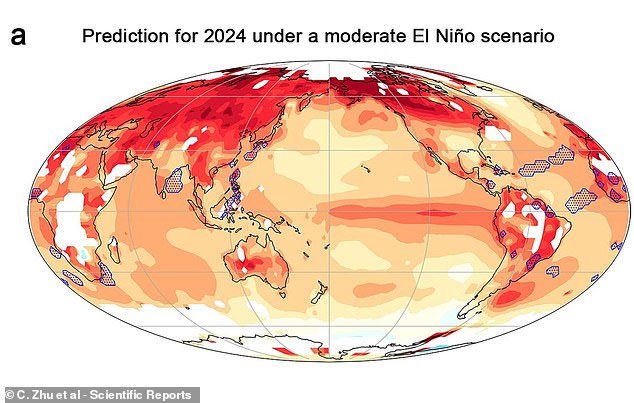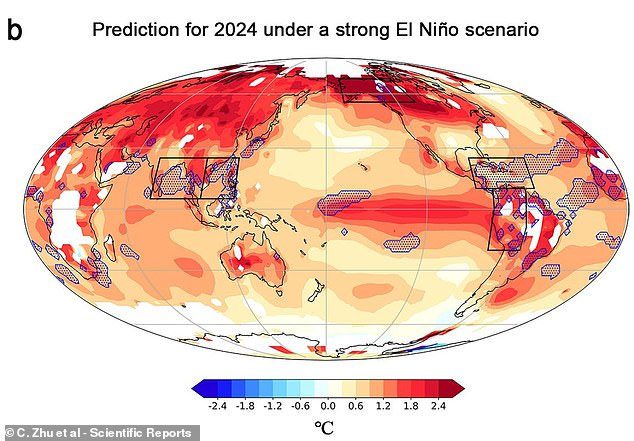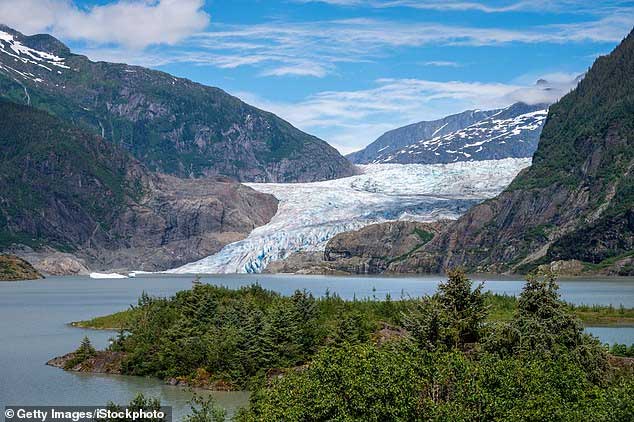2023 is recognized as a record-breaking hot year, but a new study warns that the worst is yet to come.
According to the Daily Mail, a new research model has revealed areas most likely to be scorched by record heat this year due to El Niño—an unusual warming of sea surface temperatures that occurs every few years.

On this map, the darker red areas will experience higher-than-average temperature anomalies. (Photo: Scientific Reports).
Specifically, according to experts from the Chinese Academy of Meteorological Sciences, the Bay of Bengal, the Philippines, and the Caribbean Sea are all likely to suffer from record-breaking heatwaves before June of this year.
However, this does not mean that people in other areas will remain unaffected. The study also warns of a 90% chance that the global average surface temperature will break historical records during this period.
El Niño Southern Oscillation is one of the main causes of climate variations worldwide. This phenomenon is primarily concentrated in the tropical Pacific, where warmer waters increase the global average surface temperature annually, altering climate patterns across the globe.
As the world experiences even minimal increases in average temperatures, some regions will also see significant increases in extreme local heatwaves.
The effects are so pronounced that researchers stated in a paper published in the journal Scientific Reports that it is the most powerful determining factor affecting annual climate change on the planet.
The new model shows the difference between regional average temperatures from July 2023 to June 2024 compared to the average temperatures from 1951 to 1980.
Researchers found that in a moderate El Niño scenario, the Bay of Bengal, the Philippines, and the Caribbean Sea will all experience record high temperatures over 1°C above average.
However, in a strong El Niño scenario, researchers predict that the impacts will be even more pronounced. If this occurs, regions such as Alaska, the Amazon, and the South China Sea will also reach record temperatures.

Map showing temperature deviations from average in a strong El Niño scenario. In this case, the regions of Alaska and the Amazon will also witness unprecedented temperature spikes this year (record-breaking areas are highlighted in blue dots). Photo: Scientific Reports
In Alaska, this temperature spike will be 2.4°C above the average from 1951 to 1980.
At the global level, researchers noted that even in a moderate scenario, there is a 90% chance that the average global surface temperature will break historical records this year.
In a moderate El Niño scenario, the average global surface temperature will rise by 1.03–1.10°C above the average. Meanwhile, a strong El Niño will cause temperatures to soar by 1.06–1.20°C above that average.
Researchers wrote: “Strong El Niño events can lead to a rapid increase in the average global surface temperature, potentially exceeding the ambitious 1.5°C target of the Paris Agreement on climate change in a short period.”
Concerns arise as these models also suggest that the world may face a higher risk of extreme weather phenomena.

If Alaska encounters extreme temperature phenomena, researchers warn that glaciers, like the Mendenhall Glacier (shown in the image), will melt at significantly higher rates. Photo: iStock
In Alaska, researchers noted the risk of glacier or permafrost melting, which could lead to rising sea levels or uncontrolled high temperatures.
Meanwhile, in the Amazon, extreme heatwaves increase the risk of wildfires due to drought, similar to those that ravaged vast tropical forests in 2019.
“This impending warming increases the risk of year-round marine heatwaves and raises the likelihood of wildfires, as well as other negative consequences in Alaska and the Amazon Basin,” researchers stated.

In the Amazon, models predict record temperatures could trigger drought-induced wildfires similar to those in Brazil last year (photo). (Photo: iStock)
Warmer seas also mean a greater risk of devastating tropical storms in low-lying coastal areas.
Previous studies have suggested that temperature increases due to climate change could lead to “superstorm waves” with wind speeds reaching up to 309 km/h. Unfortunately, this model also indicates that these coastal areas will be more susceptible to extreme heatwaves next year.


















































